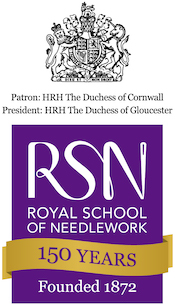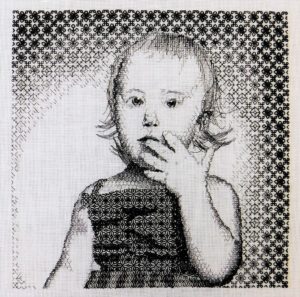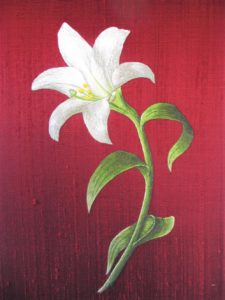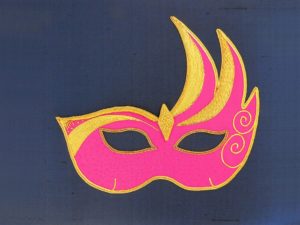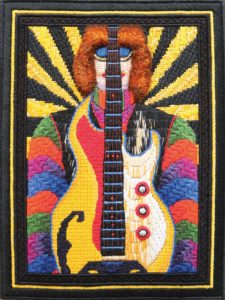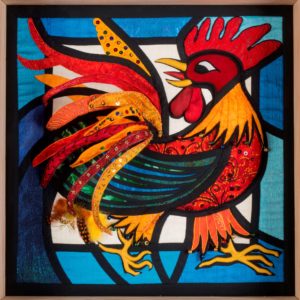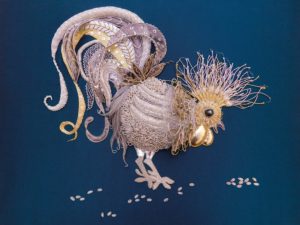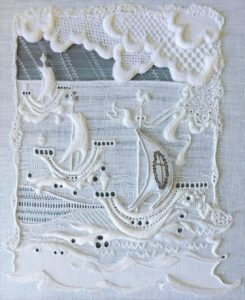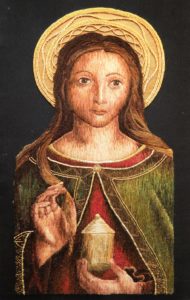Certificate and Diploma in Technical Hand Embroidery: Skills for the Future
I50 Years of the RSN: Virtual Exhibition
Introduced in the 1990s, the part-time course, Certificate in Technical Hand Embroidery, is open to all as a leisure course. It covers four techniques: Jacobean Crewelwork; Blackwork or Canvas Stitches; Silk Shading; and Goldwork. Each technique is taught over eight days, but it is entirely flexible as students can select how regularly they attend in person or, now, online. As a part-time course it is open to people of all ages and many tell us that they are signing up in later life because their parents did not believe they could make a living from embroidery when they were younger.
By the end of the 2000s, there was great demand from the Certificate students and graduates to learn further techniques, so in 2009 the Diploma was launched. This comprises a minimum of six modules, two at a more advanced level, Silk Shading and Goldwork, and four new techniques, including whichever was not done at certificate level, Blackwork or Canvas Stitches, appliqué and then a choice of Stumpwork, Canvas Shading, Basic Box Making, Pulled and Drawn Thread Whitework, Tapestry Silk Shading and Creative Goldwork. Finally, there are three advanced modules: Fine Whitework, Creative Box and Both Sides Alike.
The RSN teaches this programme at Hampton Court Palace, in Bristol, Rugby, Durham and Glasgow, as well as internationally in Japan and the USA. Since January 2021, the RSN has also taught the programme Online across three different time zones.
In these pieces it is possible to see the development of the RSN approach to the different techniques since the 1950s.
Jacobean Crewelwork
2019
Linen twill and wool thread
Bronagh Sullivan
Jacobean Crewelwork is the first technique of the Certificate as it introduces students to a large number of stitches and approaches and using woollen thread covers the surface more quickly than silk or cotton. Now the image that the students work on is based on the tree of life. The students will develop their own design with tutor guidance to balance large and small elements and will then create the stitch plan so that the piece effectively uses as many techniques as possible from four different groups of stitches.
Blackwork
2020
Linen and cotton threads
Isabel Williams
From its origins as an infill stitch, the RSN has transformed use of the Blackwork technique into the pictorial, especially being used for portraits. This then becomes a study of light and shade in stitch. The translation into embroidery is achieved with the choice of patterns (less or more dense, for example,) and with the choice of four different thicknesses of thread. To add to the depth of the picture the stitcher can also include negative space, areas left white, and create a lighter area by breaking up the patterns.
Silk Shading
2014
Silk and cotton thread
Susan Cameron
The first level of silk shading is a botanical. Silk shading is also known as painting with a needle and the most effective botanicals make you see the flower first before you see the stitching. Choosing a white flower when there are limited shades of whites and off-white threads is quite challenging.
Canvas Stitches
2020
Canvas and wool thread
Alison Elliott
Canvas Work and Blackwork can be worked at either Certificate or Diploma level. Whichever one is not worked at Certificate level has to be worked at Diploma. For the RSN, Canvas Stitches is about exploring the many different stitches that can be worked on canvas to achieve different textures or layers. This pictorial piece shows how much the RSN has moved on this technique from the old Diploma sampler style stitches.
Silk Shading
2015
Silk fabric and cotton threads
Kay Allan
Natural Silk Shading follows the direction of the fur or feathers of an animal. Kay Allan adds to this piece by also including the branch in the foreground. Look closely at the badger to see that it is not just black and white when translated into stitch. Sometimes a most unexpected colour might be seen in the animal that can really help bring the finished piece to life.
Appliqué
2014
Cotton silk and mixed threads
Teresa McAuliffe
This piece was based on a stained glass work by artist Helen Robinson. Teresa has respected the black lines of the stained glass tradition but then re-interpreted this three-dimensionally. Appliqué is the application of fabrics on top of a base layer, or underneath it when it is called reverse appliqué. They can be attached in a variety of ways to make the piece more textural.
Fine Whitework
2020
White linen and cotton threads
Gail Beer
Whitework, stitching with white thread on white fabric is considered one of the most challenging techniques. Fine Whitework includes a number of techniques including net darning, padded satin stitch, pulled work, drawn thread, Broderie Anglais. This is an advanced technique that needs close attention and is always best mounted over a contrasting shade to bring out the detail in the piece.
Tapestry Silk Shading and Goldwork – Mary Magdalene
2018
Silk, metal and cotton threads
Emma Frith
In this piece Emma combines techniques but concentrates predominantly on Tapestry Silk Shading which is used primarily for figures. Whereas for the Future Tutor Students, they have to create a whole figure so the face is often only around 1 cm square, hereby combining techniques, Emma was able to make the face much bigger which allowed for more details and expression on the face.
Tapestry Silk Shading
2018
Linen, cotton threads
Susan Chater
Tapestry Silk Shading, unlike basic and natural silk shading has to all be worked in vertical stitches, no matter the way the dress folds and drapes. It is the use of the colours which bring that to life. The name of this type of Silk Shading is taken from tapestry weaving where it looks like the figures are worked vertically, but actually they are worked on the side and turned through 90 degrees. However, for embroidery there is already a base fabric to support this stitching. to add complexity, Susan has worked two figures not just one.
